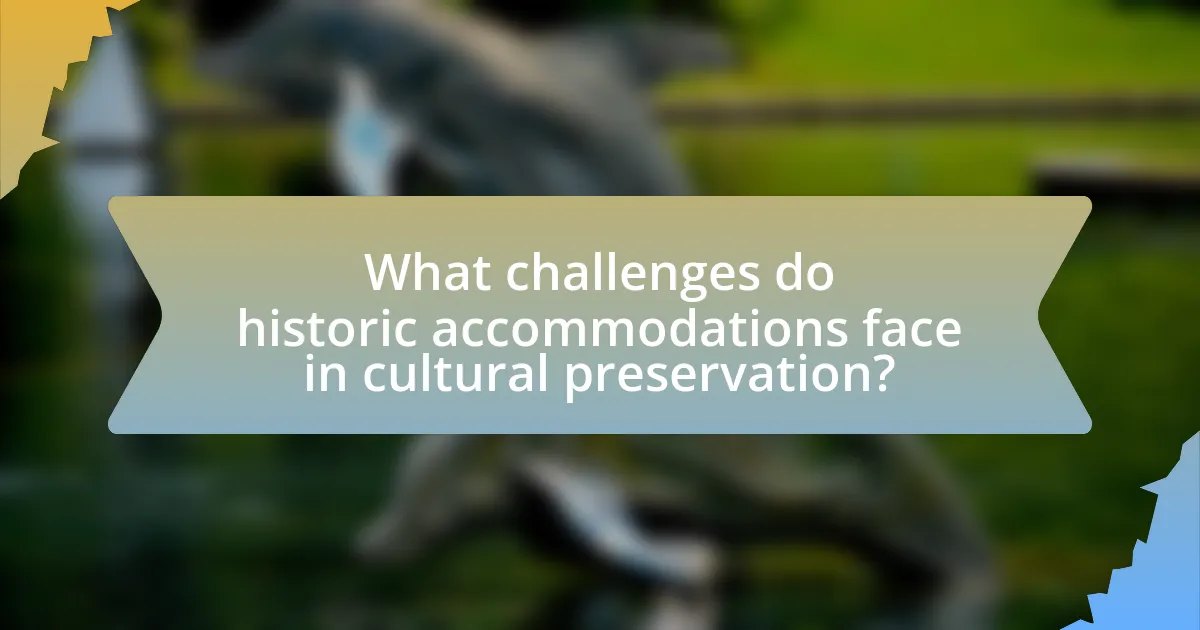Historic accommodations are vital in preserving local culture, acting as physical embodiments of a community’s history, architecture, and traditions. These establishments reflect unique regional characteristics through their design, craftsmanship, and culinary offerings, fostering cultural identity and community engagement. They serve as cultural landmarks, hosting events that celebrate local customs and traditions while also facing challenges such as financial constraints and modernization pressures. The article explores the multifaceted role of historic accommodations in cultural preservation, including their impact on local economies, community ties, and the importance of adaptive reuse and tourism initiatives in sustaining these heritage sites.

What is the role of historic accommodations in preserving local culture?
Historic accommodations play a crucial role in preserving local culture by serving as tangible representations of a community’s history, architecture, and traditions. These establishments often reflect the unique characteristics of the area, showcasing local craftsmanship and design that contribute to cultural identity. For instance, historic inns and hotels frequently incorporate regional materials and styles, which helps maintain the aesthetic and cultural narrative of the locale. Furthermore, they provide a space for cultural exchange, allowing visitors to engage with local customs, cuisine, and heritage, thereby fostering appreciation and understanding of the community’s cultural significance. Studies have shown that heritage tourism, which includes stays in historic accommodations, can enhance local economies while simultaneously promoting the preservation of cultural practices and sites.
How do historic accommodations contribute to cultural identity?
Historic accommodations contribute to cultural identity by serving as tangible representations of a community’s history, traditions, and values. These structures often reflect the architectural styles, materials, and craftsmanship unique to a region, thereby fostering a sense of belonging and continuity among residents. For example, the preservation of colonial-era inns in New England not only attracts tourism but also reinforces local narratives and heritage, as these buildings embody the stories and lifestyles of past generations. Furthermore, historic accommodations often host cultural events and activities that celebrate local customs, further embedding them into the community’s identity.
What elements of local culture are reflected in historic accommodations?
Historic accommodations reflect elements of local culture through architectural styles, traditional furnishings, and regional culinary practices. These accommodations often showcase unique building techniques and materials that are characteristic of the area, such as adobe in the Southwest United States or timber framing in Europe. Additionally, the interiors frequently feature locally crafted furniture and decor that highlight the craftsmanship and artistic traditions of the region. Culinary offerings in historic accommodations often include local ingredients and recipes, providing guests with an authentic taste of the area’s heritage. For example, inns in New England may serve clam chowder, while those in the South might offer traditional gumbo, both of which are deeply rooted in local culture.
How do historic accommodations serve as cultural landmarks?
Historic accommodations serve as cultural landmarks by embodying the architectural styles, historical narratives, and social practices of their respective eras. These establishments often reflect the cultural heritage of a region, showcasing local craftsmanship and design that contribute to a community’s identity. For example, the preservation of inns and hotels from the colonial period in the United States provides insight into early American life, including social customs and economic conditions of the time. Such accommodations often become focal points for tourism, education, and cultural exchange, reinforcing their status as landmarks that connect visitors with the local history and traditions.
Why are historic accommodations important for community engagement?
Historic accommodations are important for community engagement because they serve as tangible links to a community’s heritage and identity. These sites foster a sense of belonging and pride among residents, encouraging participation in local events and initiatives. For example, historic inns and hotels often host community gatherings, educational programs, and cultural festivals, which enhance social cohesion and promote local traditions. Research indicates that communities with preserved historic sites experience increased civic involvement, as these locations become focal points for cultural exchange and dialogue, thereby strengthening community bonds.
How do they foster connections among local residents?
Historic accommodations foster connections among local residents by serving as communal spaces for social interaction and cultural exchange. These establishments often host events, workshops, and gatherings that encourage residents to engage with one another, thereby strengthening community ties. For example, many historic inns and bed-and-breakfasts organize local art shows or culinary events that highlight regional traditions, attracting both locals and visitors. This not only promotes local culture but also creates opportunities for residents to meet and collaborate, reinforcing a sense of belonging and community identity.
What role do they play in community events and traditions?
Historic accommodations play a vital role in community events and traditions by serving as venues that foster cultural exchange and continuity. These establishments often host local festivals, workshops, and gatherings that celebrate regional heritage, thereby reinforcing community identity. For instance, historic inns and bed-and-breakfasts frequently organize events that highlight traditional crafts, local cuisine, and storytelling, which are essential for passing down cultural practices. Additionally, their architectural significance and historical narratives attract visitors, enhancing community pride and economic sustainability. This dual function of preserving history while promoting active participation in cultural traditions underscores their importance in maintaining local culture.

What challenges do historic accommodations face in cultural preservation?
Historic accommodations face significant challenges in cultural preservation, primarily due to financial constraints, regulatory hurdles, and changing societal values. Financially, maintaining and restoring historic properties often requires substantial investment, which can be difficult to secure, especially when funding sources prioritize modern developments over preservation efforts. Regulatory challenges arise from strict preservation laws that can complicate renovations or adaptations needed to meet contemporary safety and accessibility standards. Additionally, societal values may shift, leading to decreased interest in preserving certain cultural narratives associated with historic accommodations, which can result in neglect or abandonment of these sites. These factors collectively hinder the effective preservation of cultural heritage within historic accommodations.
How do modernization and urban development impact historic accommodations?
Modernization and urban development significantly impact historic accommodations by often leading to their deterioration or complete loss. As cities expand and modernize, historic buildings may be repurposed or demolished to make way for new infrastructure, which can erase cultural heritage. For instance, a study by the National Trust for Historic Preservation found that over 1,000 historic sites in the United States have been lost to urban development in the past decade alone. This trend not only diminishes the architectural diversity of urban landscapes but also disrupts the continuity of local culture and history, as these accommodations often serve as tangible links to a community’s past.
What are the risks of neglecting historic accommodations?
Neglecting historic accommodations poses significant risks, including the loss of cultural heritage, economic decline, and environmental degradation. When historic sites are not maintained, unique architectural styles and local histories can be irreversibly damaged or destroyed, leading to a diminished sense of identity within the community. Economically, these accommodations often attract tourism; their neglect can result in decreased visitor numbers, which impacts local businesses and job opportunities. Furthermore, environmental risks arise as deteriorating structures may lead to unsafe conditions, contributing to urban decay and potential hazards for surrounding areas. According to the National Trust for Historic Preservation, communities that invest in preserving historic sites often see a return on investment of up to $4 for every $1 spent, highlighting the economic benefits of maintaining these accommodations.
How can communities balance development with preservation?
Communities can balance development with preservation by implementing zoning regulations that protect historic sites while allowing for new construction. For example, cities like Charleston, South Carolina, have established historic districts that limit the height and style of new buildings to maintain the character of the area. This approach not only safeguards cultural heritage but also promotes tourism, as visitors are drawn to well-preserved historic environments. Additionally, engaging local stakeholders in the planning process ensures that development projects reflect community values and priorities, fostering a sense of ownership and responsibility towards both progress and preservation.
What financial challenges do historic accommodations encounter?
Historic accommodations encounter significant financial challenges primarily due to the high costs of maintenance and restoration. These properties often require specialized materials and skilled labor to preserve their unique architectural features, which can lead to expenses that exceed those of modern accommodations. Additionally, historic accommodations may face restrictions on renovations imposed by preservation laws, limiting their ability to adapt to changing market demands and increasing operational costs. According to the National Trust for Historic Preservation, maintaining historic properties can cost up to 30% more than standard buildings, highlighting the financial strain on these establishments.
How can funding and grants support preservation efforts?
Funding and grants can significantly support preservation efforts by providing essential financial resources needed for restoration, maintenance, and operational costs of historic sites. These funds enable organizations and local governments to undertake projects that safeguard cultural heritage, such as repairing structural damage, updating facilities to meet safety standards, and enhancing visitor experiences. For instance, the National Park Service’s Historic Preservation Fund has allocated millions of dollars to various preservation projects across the United States, demonstrating the impact of financial support on maintaining historical integrity and promoting community engagement.
What role do local businesses play in sustaining historic accommodations?
Local businesses play a crucial role in sustaining historic accommodations by providing essential services and fostering community engagement. These businesses, such as restaurants, shops, and tour operators, create a symbiotic relationship with historic accommodations, attracting visitors who contribute to the local economy. For instance, a study by the National Trust for Historic Preservation found that heritage tourism, which often includes stays in historic accommodations, generates significant revenue for local businesses, thereby incentivizing their support for preservation efforts. This collaboration not only enhances the visitor experience but also ensures that historic sites remain economically viable and culturally relevant within the community.

What strategies can enhance the role of historic accommodations in cultural preservation?
Historic accommodations can enhance cultural preservation through adaptive reuse, community engagement, and educational programming. Adaptive reuse allows historic buildings to serve modern functions while retaining their architectural integrity, as seen in the transformation of warehouses into boutique hotels, which maintains the historical context. Community engagement fosters local pride and involvement, exemplified by initiatives where residents participate in decision-making processes regarding the preservation of their heritage sites. Educational programming, such as guided tours and workshops, raises awareness about local history and traditions, effectively connecting visitors with the cultural significance of these accommodations. These strategies collectively contribute to the sustainability and relevance of historic accommodations in preserving local culture.
How can tourism be leveraged to support historic accommodations?
Tourism can be leveraged to support historic accommodations by increasing their visibility and generating revenue that can be reinvested into preservation efforts. When tourists choose to stay in historic accommodations, they contribute to the local economy, which can lead to funding for maintenance and restoration projects. For instance, a study by the National Trust for Historic Preservation found that heritage tourism can create jobs and stimulate local economies, with historic sites attracting millions of visitors annually. This influx of tourists not only helps sustain these accommodations but also promotes cultural heritage, ensuring that local traditions and histories are preserved for future generations.
What types of tourism initiatives can promote local culture through historic accommodations?
Tourism initiatives that promote local culture through historic accommodations include cultural heritage tours, community-based tourism, and immersive experiences. Cultural heritage tours often involve guided visits to historic sites and accommodations, allowing tourists to learn about local traditions and history. Community-based tourism encourages collaboration between visitors and local residents, fostering cultural exchange and supporting local economies. Immersive experiences, such as workshops in traditional crafts or cooking classes featuring local cuisine, enable tourists to engage directly with the culture, enhancing their understanding and appreciation of the local heritage. These initiatives not only preserve local culture but also contribute to sustainable tourism practices by ensuring that the benefits of tourism are shared with the community.
How can visitor experiences be designed to educate about local culture?
Visitor experiences can be designed to educate about local culture by integrating authentic cultural elements into the activities and environments that visitors engage with. For instance, historic accommodations can offer guided tours that highlight the architectural styles, historical significance, and cultural narratives of the area, allowing visitors to connect with the local heritage. Additionally, incorporating local cuisine into dining experiences can provide insights into traditional practices and ingredients, fostering a deeper understanding of the culture. Research indicates that immersive experiences, such as workshops on local crafts or storytelling sessions led by community members, enhance cultural appreciation and retention among visitors. These methods not only inform but also engage visitors, making the learning process more impactful and memorable.
What best practices can be implemented for effective preservation?
Effective preservation of historic accommodations can be achieved through several best practices, including regular maintenance, community engagement, and adaptive reuse. Regular maintenance ensures that the structural integrity and aesthetic qualities of historic buildings are upheld, which is supported by the National Park Service’s guidelines that emphasize the importance of routine inspections and repairs. Community engagement fosters local support and awareness, as demonstrated by successful preservation initiatives that involve local stakeholders in decision-making processes. Adaptive reuse allows historic accommodations to serve modern purposes while retaining their historical significance, a practice endorsed by the National Trust for Historic Preservation, which highlights numerous case studies where such approaches have revitalized communities and preserved cultural heritage.
How can community involvement be encouraged in preservation efforts?
Community involvement in preservation efforts can be encouraged through education, outreach programs, and collaborative projects. Educational initiatives, such as workshops and seminars, inform residents about the significance of local heritage and the benefits of preservation. Outreach programs, including community meetings and social media campaigns, foster dialogue and gather input from community members, making them feel valued in the process. Collaborative projects, such as volunteer days for restoration work, create hands-on opportunities for residents to engage directly with preservation activities. Research indicates that communities with active participation in preservation efforts report a stronger sense of ownership and pride in their local culture, leading to sustained engagement and support for future initiatives.
What are some successful case studies of historic accommodations preserving culture?
Successful case studies of historic accommodations preserving culture include the Hotel de Ville in France, which has maintained its original architecture and local traditions since the 17th century, serving as a venue for cultural events and community gatherings. Another example is the Raffles Hotel in Singapore, which has preserved its colonial heritage while showcasing local art and cuisine, thus promoting Singaporean culture to international visitors. Additionally, the Parador de Santiago de Compostela in Spain, housed in a historic building dating back to the 15th century, plays a crucial role in preserving Galician culture through its architecture and culinary offerings. These accommodations not only provide lodging but also serve as cultural ambassadors, reinforcing local identity and heritage.
What practical steps can individuals take to support historic accommodations?
Individuals can support historic accommodations by visiting and staying in these establishments, which directly contributes to their financial sustainability. Frequent patronage helps maintain the properties and supports local economies. Additionally, individuals can participate in preservation efforts by volunteering for restoration projects or donating to organizations focused on historic preservation. Engaging in community advocacy for policies that protect historic sites also plays a crucial role. According to the National Trust for Historic Preservation, heritage tourism generates significant economic benefits, emphasizing the importance of supporting these accommodations for cultural preservation.